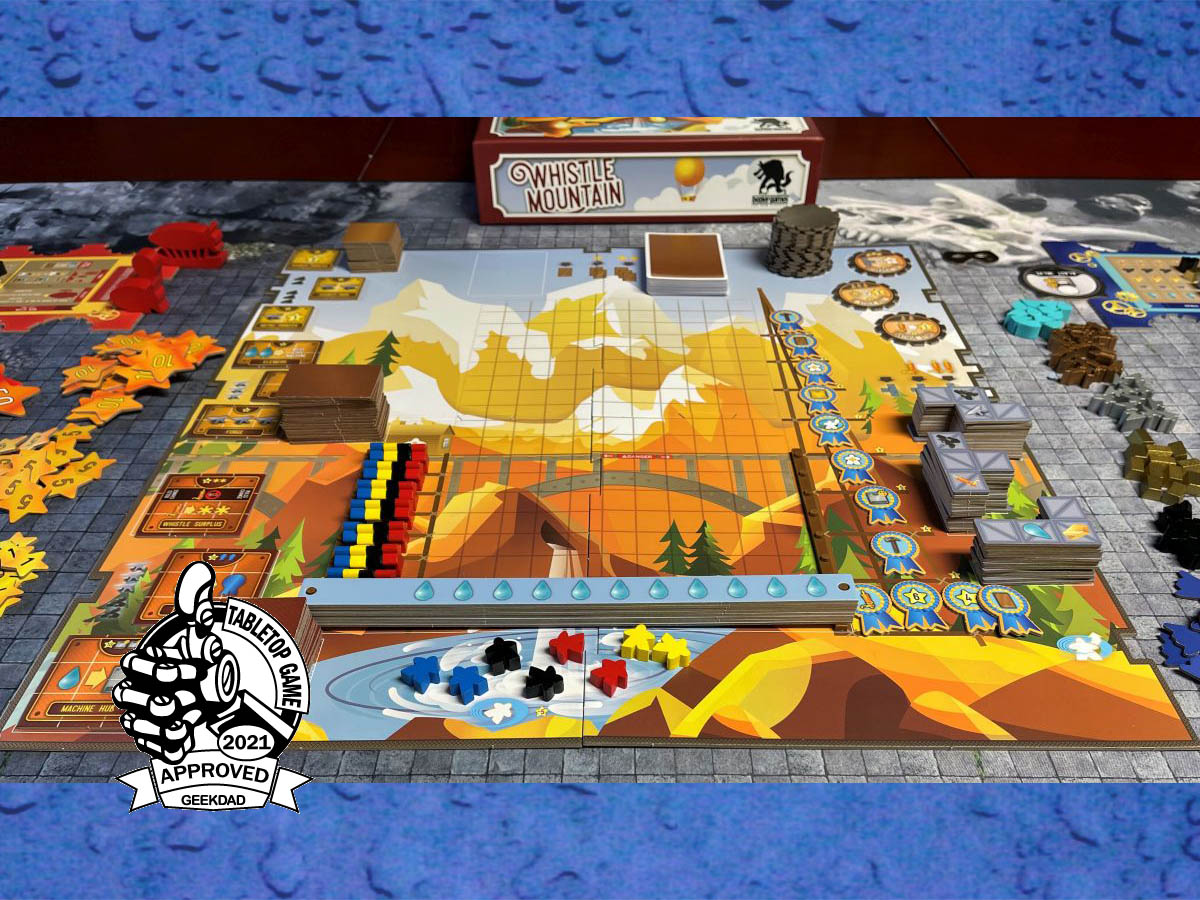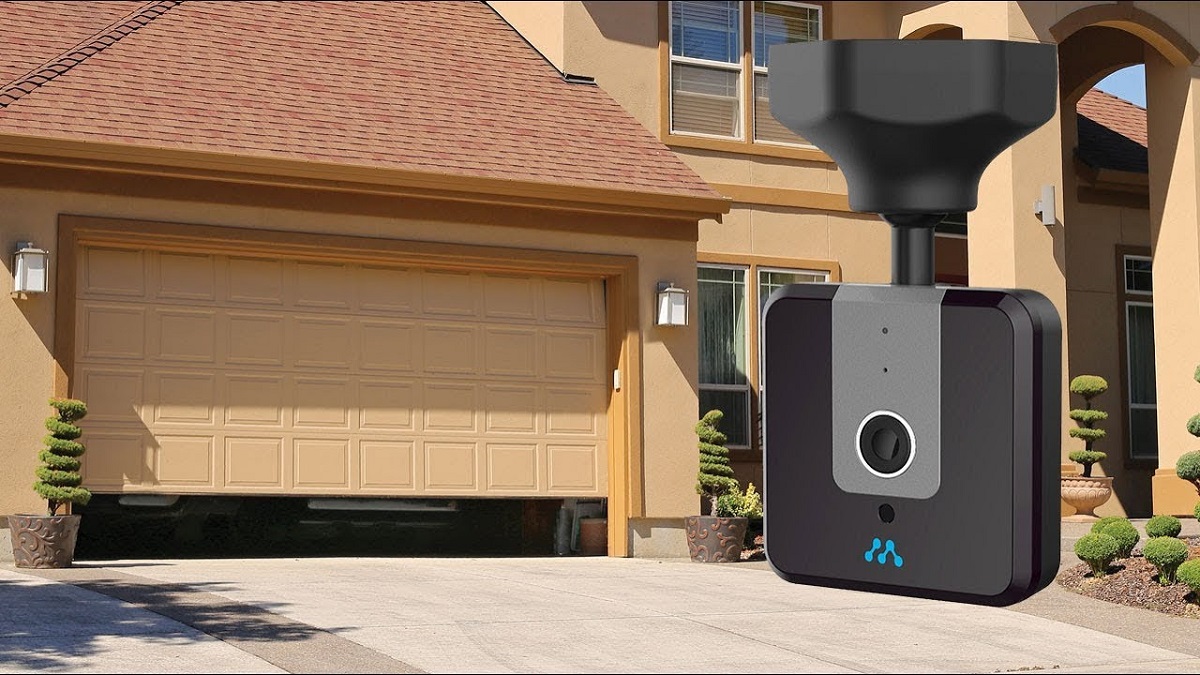Take the vast resources of the Rocky Mountains and use them to construct fantastic machines!
What Is Whistle Mountain?
Whistle Mountain is a game of worker placement and tile placement. It’s for 2-4 players, ages 14 and up, and takes about 60 to 90 minutes to play. It retails for $69.95 and is currently available to purchase on Amazon, directly from Bezier Games, or from game stores.
Whistle Mountain was designed by Scott Caputo and Luke Laurie, and published by Bezier Games, with illustrations by Mila Harbar and Taylor Bogle.
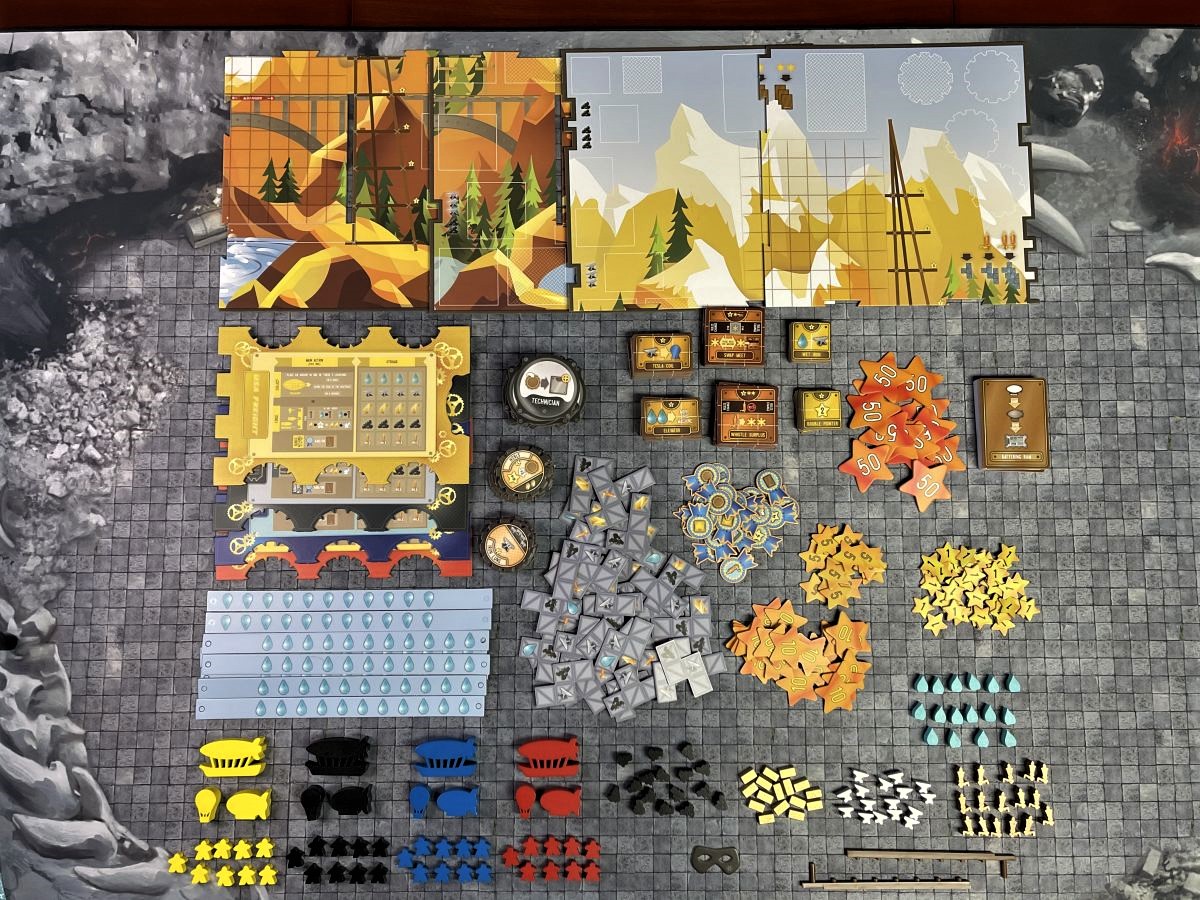
Whistle Mountain Components
The box contains the following:
- (1) 4-piece Gameboard
- 4 Player Boards
- 2 Water Bar Holders
- 8 Water Bars
- 24 Awards
- 1 Duplicator Token
- 42 Scaffolds
- 17 Starter Abilities
- 24 Upgrades
- 16 Small Machines
- 20 Medium Machines
- 18 Large Machines
- 4 Hot Air Balloons
- 4 Blimps
- 4 Dreadnoughts
- 36 Worker Tokens
- 16 Coal Tokens
- 16 Iron Tokens
- 16 Water Tokens
- 16 Gold Tokens
- 16 Whistle Tokens
- 40 Cards
- 40 1VP Stars
- 16 5VP Stars
- 23 10VP Stars
- 13 50VP Stars

The four pieces of the Whistle Mountain game board lock together easily. I like that there are notches along the top and sides of the board for docking your airships(which are the workers that you place during the worker placement phase of the game). The stylized artwork of the Rocky Mountains is very nice visually, but also not overpowering when it comes to navigating the board. All of the important gameplay areas are clearly visible and easy to find.
There are also notches in the two bottom board pieces to accommodate the plastic water bar holders. The water bars provide a physical and visual representation of the rising waters that occur during the course of the game.

If you’ve read any of my previous reviews, you know what a big fan I am of fun meeples. Well, Whistle Mountain has them in spades. Each player will get three different wooden airships and a number of wooden meeples in their chosen player color.

All of the different collectible resources in the game are also wooden. Here are all of them except the water tokens, which are represented by blue droplets:

That doesn’t mean that the game skimps on the cardboard components, either. Each player has a board in their player color which has areas to place the resources you collect, as well as reminders of what actions are available during the Collect and Forge phases of your turn. Additionally, there are cut out sections to perfectly hold upgrades, starting abilities, and your airships.


All of the cardboard components are of the same thick, quality cardboard. The colors and graphics match the aesthetic of the player board and have a somewhat Old West, steampunk vibe to them like the TV show and movie of Wild, Wild West.


How to Play Whistle Mountain
You can download a copy of the rulebook here.
The Goal
The goal of Whistle Mountain is to score the most Victory Points by building scaffolding and machines, upgrading your abilities, and promoting your workers.
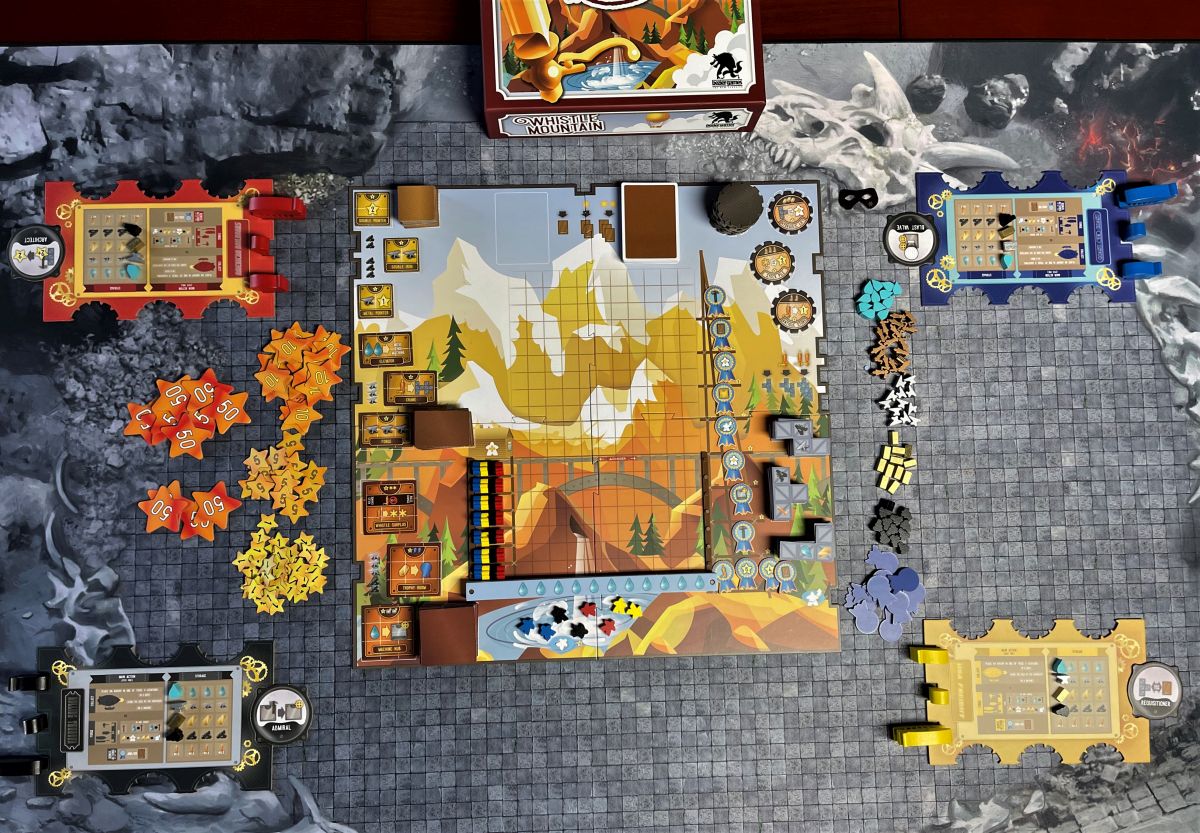
Setup
Assemble the game board and place it in the middle of the table. Shuffle the small, medium, and large machine tiles, and place three of each in their corresponding spaces on the game board, along with the facedown stacks of tiles.

Insert the two plastic water bar holders into the slots, and then stack all of the water bars on the bottom pegs.
Create a supply of resources near the game board, as well as a supply of VP Stars. Place 4 “rescue” awards on the lowest level of the tower on the game board, then place one random award faceup on each other level of the tower. Create a supply of facedown awards near the game board.
Stack the scaffolds on their respective spaces on the game board. Shuffle the upgrades, then randomly place 3 upgrades on their spaces on the board, as well as the stack of facedown upgrades. Shuffle the cards, and place them facedown in the draw pile on the board.

After randomly choosing a starting player, each player takes a player board, and 3 airships and 9 meeples in matching color. 1 worker is placed on each level of the barracks, with the remaining 2 placed in the whirlpool below the water boards.
Each player starts with 1 coal, 1 iron, 1 gold, and 1 water. Player 2 also gets 1 extra water, Player 3 takes 1 whistle, and Player 4 gets 1 whistle and 1 extra water.
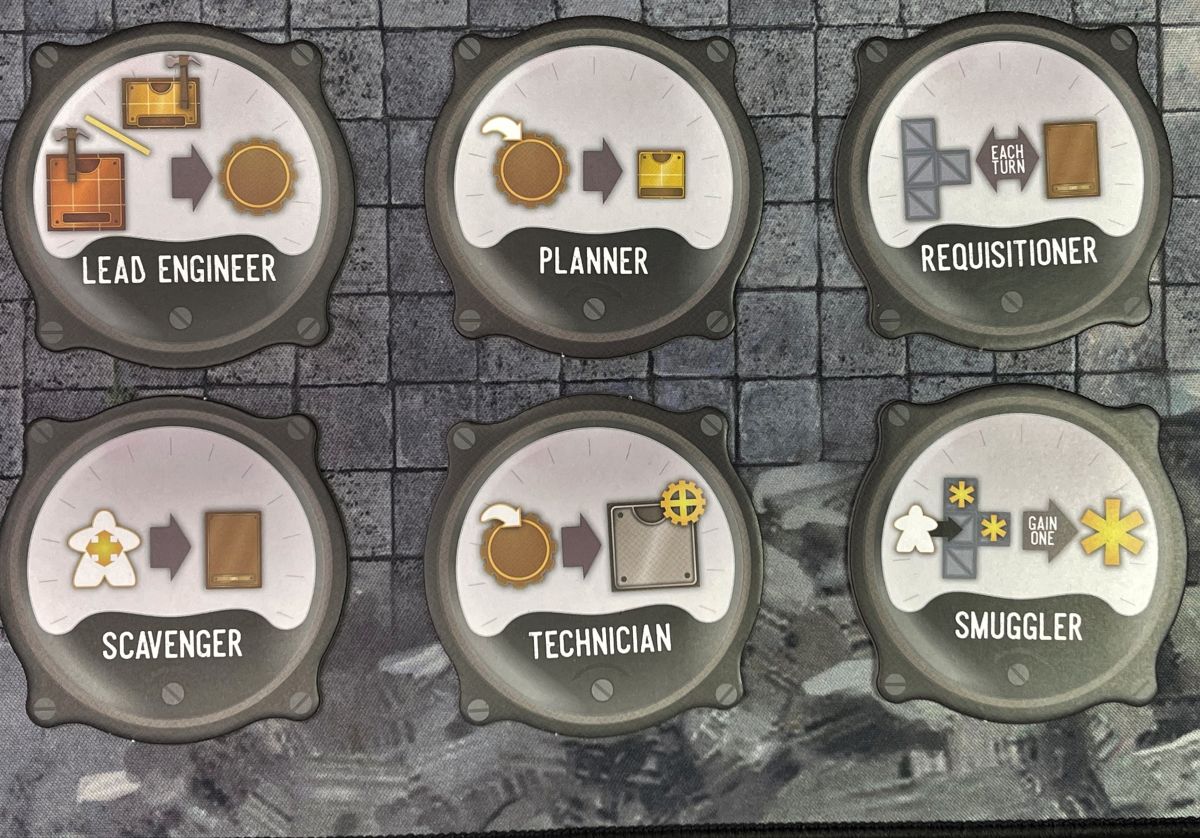
Starting with whichever player is going last, draw a number of starting abilities equal to the number of players+1. That player keeps the starting ability of their choice, then passes the remainder to the right. The starting player discards the unused ability.
Finally, beginning with the first player and proceeding clockwise, each player draws 2 scaffolds off of a single stack. They place one of them so that at least one edge of the scaffold aligns with the bottom of the grid on the game board, and keeps the other in their storage.

Gameplay
Note: While Bezier Games sent me out a physical copy of the game to review, thanks to the pandemic, I chose to play Whistle Mountain with some friends on Tabletopia. While it would definitely be more enjoyable to play in person (especially with all the delightful components), the digital version worked out surprisingly well. Plus, I was able to play with both my friend Chris in Los Angeles and my friend Jason in Sweden, which would have been a difficult task to pull off even if there wasn’t a global pandemic. (Though I should mention that Jason suffered from a lot of lag and disconnects, which Chris and I did not experience.)
Beginning with the starting player and proceeding clockwise, each player on their turn may take one Main Action (Collect or Forge) and one or both Bonus Actions.
Collect
To take a collect action, take one of your airships that is docked on your player board, and place it either at an open dock on the game board, on the grid, or on a machine.
At an open dock. Place any of your airships into an open dock, and take the action for that space. Some of those spaces will have associated costs:
- Small machine dock. Spend 2 coal to gain one small machine, or 3 coal if you take the 2nd dock space.
- Medium machine dock. Spend 3 iron to gain one medium machine.
- Large machine dock. Spend 3 iron and 2 coal to gain one large machine.
- Rescue dock. Rescue one of your workers from the whirlpool and place them on any empty scaffold space.
- Scaffold docks. Gain 1 scaffold for free from the top of a stack, spend 1 whistle to gain any two scaffolds or 2 whistles to gain any three scaffolds.
- Upgrade dock. Spend the cost printed on the top of a faceup upgrade to immediately acquire and slot onto your player board. Those abilities are now available to that player.
- Card dock. Gain one facedown card for free, spend any 1 resource to gain two cards, or any 2 resources to gain three cards.

On the Grid or on a Machine. One of the airships docked on your player board must be placed on either the open grid on the game board or on a machine, such that the airship completely fits without overlapping onto another machine, airship, or scaffolding. You would then immediately gain any resources from scaffolding or water bars that are orthogonally adjacent to your airship, and could then activate any machines you were either on(if placing on a machine) or adjacent to.
Note: whistle tokens are wild and count as any of the other resources.
Forge
Start by returning any of your airships from the game board to the docks on your player board. You may then do up to three Builds and one Move or Rescue.

Build. You can build scaffolds and machines that you have in storage. Your first build is free; the second and third builds cost 1 water each.
- Building scaffolds. Take one of your scaffolds and place it adjacent to an existing scaffold or machine. Gain one VP for each segment of the scaffold that is touching another scaffold or machine.
- Building machines. A machine must wholly fit onto the scaffolding. When you place a machine, first promote any workers by moving them straight across the grid to a tower space. If there are any awards remaining on that tower level, then the first worker to arrive there gains the award. Additionally, you would then immediately score however many victory points that the machine is worth. Finally, if you have built a machine above the level of the bridge on the game board, then the canyon floods. Add 1 water bar for each machine you have built that reaches above the level of the bridge. Any workers on scaffolding that are covered by water bars are knocked into the whirlpool. Any airships covered by water bars are returned to their respective player’s docks. And any machines partially covered by water may no longer be activated.
Move. Spend 1 gold to move any 1 of your workers from the barracks to any empty space on a scaffold.
Rescue. Spend 2 gold to rescue 1 worker from the whirlpool and place them on any empty space on a scaffold.

Bonus Actions
One or both of these can be taken on any of your turns:
- Play one card. Carry out the effects shown on the card, then discard it. In the example above, Remote Trigger allows you to activate any machine, while Craft allows you to spend 1 gold to immediately build a scaffold or machine.
- Redeem an award. Carry out the effects of an award from your storage, then discard.

Game End
When no more workers remain in the barracks, the game end is triggered. The active player finishes their turn, and then each other player gets one more turn. At that point, the game ends, and you proceed to scoring. Add up all of the Star VP that you’ve collected. Additionally:
- Score VP for each worker on a floor of the tower, based on which level they are on.
- Lose 5 VP for each worker in the whirlpool.
- Score the VP shown on each upgrade.
- Score for items remaining in your storage: 1 VP for each machine, 1 VP for each award, 1 VP for every 2 scaffolds, 1 VP for every 2 cards, and 1 VP for every 4 resources.
The player with the most resources wins, and ties are decided by whoever has the most items left in storage.
Whistle Mountain is GeekDad Approved!
Why You Should Play Whistle Mountain
Whistle Mountain is a game that you will find yourself getting lost in, and I mean that in a good way. Time will melt away as you build up your structures and gather resources. As your resources grow, so too will your options. You’ll start to refine your strategies, adding upgrades that will change the rules for you. And, like in other worker placement games, you’ll try to anticipate where your opponents may intend to place their workers, and get there first.
But unlike most worker placement games, you have more areas (and types of workers) to concern yourself with. Any of your three airships will fit in any of the docks along the game board, but as they’re of three different sizes, you’ll need to anticipate where you can maximize your placements for gathering resources. You also have to figure out when it’s a good time to move or rescue your barracks workers. Ideally, you want to place them so that you can build a machine on their location, which will promote them onto tower spaces, earning you points and possibly awards. The higher the tower floor, the more points at the end of the game for your workers. However, as you and your opponents build higher and higher, you’ll start flooding the canyon, which will render previous machines useless and drop workers who aren’t safe on the tower into the whirlpool.

You can’t ignore those workers that land into the drink, either. If you wait too long to rescue them, you’ll lose 5 VP per worker, and that could end up costing you the game. And it’s not just building machines above the bridge that can cause workers to fall into the whirlpool. Some of the large machines can make workers plunge into the water.
How you play each game will likely be shaped by whichever starting ability you have. On our first game, Chris had chosen “Architect” for his starting ability, which gave him an additional 2 VP every time he built a scaffold that scored him at least 2 VP. Naturally, he was very focused on building scaffolds during the game and acquiring whistles which would allow him to purchase more scaffolds on a single turn.

While “Architect” is a fairly straightforward path towards earning victory points, other starting abilities can be just as strong, especially when combined with the right upgrades. As you can see above, I had chosen “Planner,” which gave me a free small machine every time I acquired an upgrade. This required a bit more tactical planning on my part, as I would need to gather the resources required to purchase upgrades, as well as be sure to be first to the upgrade dock once I had those resources so that I could acquire the upgrade of my choice. And there was at least once when I was beaten to the punch by another player. During the course of the game, I acquired “Rapid Loader,” which gave me victory points every time I activated a machine, and (though not pictured) I also purchased “Stash,” which gave me an additional 2VP for each of my upgrades at the end of the game.
Part of the delight of the game is in building your game engine. There are upgrades, machines, and cards that allow you to change the different rules of the game. If you get the “Lifeboat” upgrade, you don’t have to worry about rescuing workers from the whirlpool: at the end of the game, they’re worth 0 VP instead of -5 VP. You could use the “Secret Door” card to either move one of your workers higher up the tower, or, if you’re a jerk, one of your opponent’s workers lower on the tower.
Thanks to the variety in Whistle Mountain, no two games will be the same. It plays well at all player counts, and while some of the starting abilities may seem to give an edge over others, all of them can be useful. There are a lot of different icons to learn in the game, which may be overwhelming at first. But the rulebook has a clear guide not only to what each icon means, but also to exactly how each machine, starting ability, upgrade, card, and award works. You will definitely find yourself referring to this guide during your first few games.
However, this is not a difficult game to learn. You will quickly jump into planning out where to place your airships for maximum benefit, and when it’s advantageous to switch to forging before you’ve placed all your airships. There are a lot of meaningful choices to make in Whistle Mountain, but none of them are overwhelming. And most importantly, Whistle Mountain is a lot of fun to play. This is the first game I’ve reviewed in 2021, and I’m happy to say that as far as board games go, my year is off to a very good start.
Click here to see all our tabletop game reviews.
![]() To subscribe to GeekDad’s tabletop gaming coverage, please copy this link and add it to your RSS reader.
To subscribe to GeekDad’s tabletop gaming coverage, please copy this link and add it to your RSS reader.
Disclosure: GeekDad received a copy of this game for review purposes.
